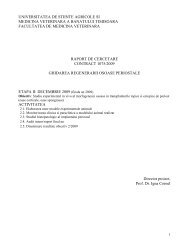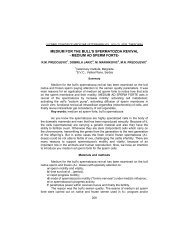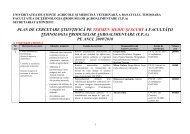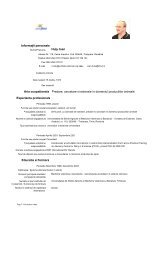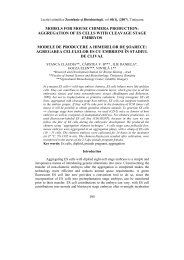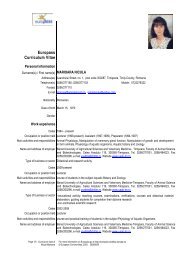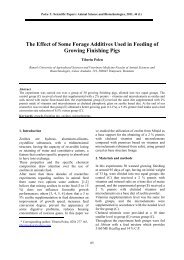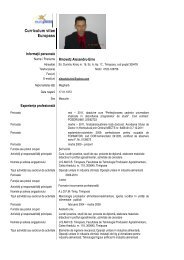Animal Science and Biotechnologies, 2011, 44 (2)
Animal Science and Biotechnologies, 2011, 44 (2)
Animal Science and Biotechnologies, 2011, 44 (2)
Create successful ePaper yourself
Turn your PDF publications into a flip-book with our unique Google optimized e-Paper software.
Negrea O. et. al./Scientific Papers: <strong>Animal</strong> <strong>Science</strong> <strong>and</strong> <strong>Biotechnologies</strong>, <strong>2011</strong>, <strong>44</strong> (2)<br />
Scomber scombus <strong>and</strong> 18 pieces herring - Clupea<br />
heringus), packed in plastic bags (3-5 pieces per bag)<br />
<strong>and</strong> a variable weight (200-400 g). We mention that the<br />
fish taken in the study came from the waters of Norway<br />
<strong>and</strong> Spain, imported <strong>and</strong> packed by specialized<br />
companies in Romania in the field. After thawing,<br />
macroscopic examination was performed by opening<br />
the general cavity, following intestinal parasites,<br />
changes of organs in general cavity <strong>and</strong> lesion table<br />
produced in gut level by larval stages of Anisakis sp.<br />
From parasitized specimens were collected parasites in<br />
Petri dishes with 10% formalin solution for some<br />
morphological measurements. To appreciate the<br />
intensity of larval parasitism, were evaluated<br />
numerically parasites located in the gut, setting:<br />
- low infestation, under 5 parasites/ fish<br />
- medium infestation, between 5 – 10 parasites/fish<br />
- high infestation, above 10 parasites / fish.<br />
There have been done some morphological<br />
measurements (length, width, color) on a sample of 20<br />
larvae collected, using a millimeter graduated linear.<br />
3. Results <strong>and</strong> discussion<br />
Investigations conducted on a sample of 33 marine<br />
fish, non eviscerated <strong>and</strong> frozen, buy in the<br />
supermarket chain stores, the incidence <strong>and</strong><br />
intensity of parasitism by larval Anisakis sp,<br />
lesion table caused <strong>and</strong> some morphological<br />
measurements, reveals the following aspects:<br />
A. Parasitism incidence with Anisakis sp larva in<br />
consumption marine fish is presented in<br />
accompanying table.<br />
The data presented in the table below highlights a<br />
high level of anisakiosis in marine fish by 60.0% to<br />
72.2% in mackerel <strong>and</strong> herring, with an average of<br />
66.6%. Like other helmintozis found in fish<br />
(freshwater <strong>and</strong> marine fauna) <strong>and</strong> nematodes<br />
responsible anisakiasis, in their biological cycle<br />
requires a definitive host (ichtiofage marine<br />
mammals) <strong>and</strong> 2-3 intermediate hosts (capepodes<br />
crustaceans <strong>and</strong> marine fish ) in which the body<br />
develops stages larval L1 - L4. [1, 2, 3, 4].<br />
Contamination of marine <strong>and</strong> ocean fish is more<br />
intense, the higher is the most developed invertebrate<br />
fauna (food source for fish). Thus the incidence of<br />
parasites in marine fish crustacean is correlated with<br />
the amount consumed <strong>and</strong> their pollution level<br />
especially with larvae Anisakis spp [5, 2].<br />
Variety of intestinal infestation with larvae of<br />
Anisakis sp from marine fish consumption,<br />
depending on the species is shown in Figure 1.<br />
Table 1. Anisakiosis incidence in comsumption marine fish<br />
Species Total tested samples From which positive %<br />
Mackerel 15 9 60.0<br />
Herring 18 13 72.2<br />
Total 33 22 66.6<br />
80<br />
60<br />
40<br />
60<br />
72,2<br />
66,6<br />
20<br />
0<br />
Mackerel Herring Total<br />
Figure 1. Variety of intestinal infestation with larvae of Anisakis sp.<br />
B. Infestation intensity level with the larvae of<br />
Anisakis sp in consumption marine fish, on fish<br />
lot taken in the study, is presented in Table 2. The<br />
data presented in Table 2 highlights the different<br />
levels of intensity Anisaki sp larvae parasitism,<br />
depending on the species, as follows:<br />
36



